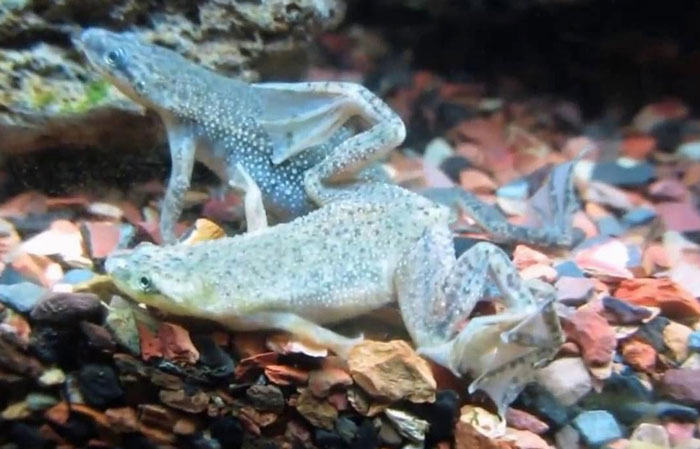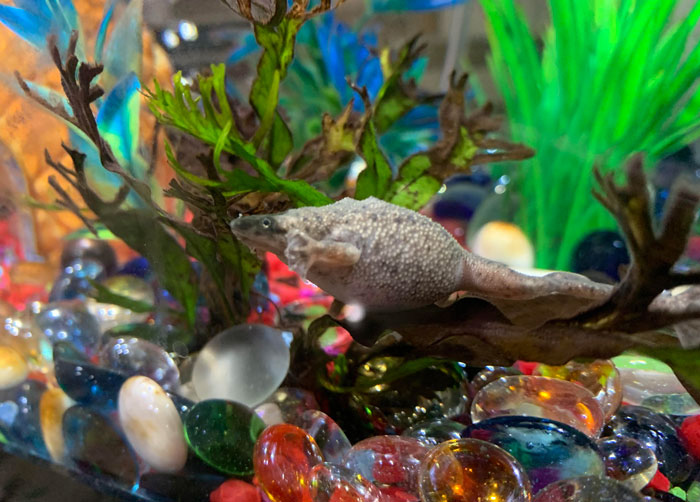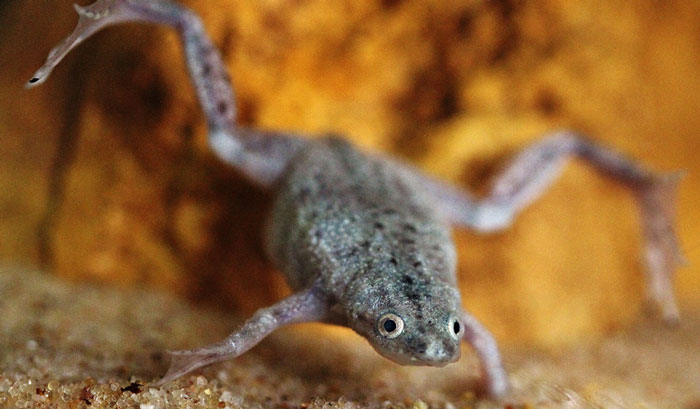Like most of the other frog species, the African dwarf frog reproduces by laying eggs. If you own an African dwarf frog pet or are interested in knowing more about it, then you may be asking yourself what its eggs look like.
What do African dwarf frog eggs look like? The African dwarf frog eggs are usually small, round, and clear, with a small black dot at the center which is the developing embryo. However, unfertilized African dwarf eggs have a whitish or cloudy appearance.
In this article, we explore more details about how African dwarf frogs look like, how big they are, and where they usually lay them. We’ll also discuss what to do with the frog eggs, how to tell if they’re fertile and more.
What do African dwarf frog eggs look like?
African dwarf frog eggs are typically tiny (2 to 3 millimeters) and seem to have small black dots in the middle to your naked eye. They are covered in mucus when the female lays them.
These eggs need to stay moist hence the female lays them on the surface of water. However, some of the frog eggs may sink to the bottom of the tank.

These frog species are known to lay many eggs—between 700 and 1500 eggs per clutch—and are usually laid in clusters.
When the eggs are first laid, they’re quite soft and delicate. If you’re not careful, you can easily damage or disturb them, minimizing their hatching possibility.
Now, these eggs develop into tadpoles quite fast, in around 2 to 7 days, provided a male African clawed frog fertilizes them.
Among the many eggs the frog lays, not all of them are fertilized. The unfertilized eggs have a cloudy or whitish appearance.
These unfertilized eggs won’t develop into tadpoles and you’re advised to separate them from the fertilized ones.
What to do with African dwarf frog eggs
If your African dwarf frog lays eggs and you want them to hatch into tadpoles, then you should take the necessary steps to take proper care of them.
Here are some helpful tips on how to take good care of African dwarf frog eggs:
Start by moving the breeding pair to a separate tank. African dwarf frogs, like most other frogs, do not show any parental care for their eggs. In fact, the frogs may start eating the eggs after laying them. Therefore, transferring them to a separate tank is the first step to saving their eggs.

You should also get rid of any damaged and unfertilized eggs in the tank. Unfertilized eggs usually have a milky appearance. Any eggs that sink at the bottom of the tank are also unlikely to hatch, so you should remove them as well.
Once you have the healthy eggs in the tank, adjust the tank water temperature to around 78 and 80 degrees Fahrenheit. The water pH should fall between 6.5 and 7.5 and water hardness should be between 5-20 dGH.
These are the perfect water parameters for the frog eggs to hatch and tadpoles to develop normally.
Be sure to dim any light source in the breeding tank. If possible, you should get a red light or backlight specially made for hatching the eggs as well as raising tadpoles.
After you have set all the ideal conditions, give the eggs around 48 hours to start hatching into the tadpoles.
How do African dwarf frogs lay eggs?
For the African dwarf frogs to lay eggs, they must first mate with a male. This frog species usually hit sexual maturity at around 9 years of age.
During the mating season, the male grabs the female from behind, in amplexus mating position.
Now, as the female starts laying the eggs, the male also releases his sperm on them, thus fertilizing them through external fertilization.
Afterward, the eggs will start development into tadpoles, which take roughly 2-7 days.
However, some of the frog eggs may go unfertilized. These can be easily identified by a cloudy or whitish appearance and they lack a black center dot (embryo).
This video gives you a close-up of how African dwarf frogs lay eggs:
Video:
Where do African dwarf frogs lay eggs?
Once the male and female have engaged in amplexus, they will typically swim up from the floor of the aquarium to the tank surface and then back to the floor.
However, every time they reach the surface, the female usually releases eggs on the aquarium surface. This means when the frog lays her eggs, you’ll most probably see them floating on the water surface.

What does a pregnant African dwarf frog look like?
An African dwarf frog pregnant has specific signs that you should keenly look for. The most common sign of a pregnant African dwarf frog is a large, swollen stomach.
As we said earlier, these frogs can lay anywhere from 700 to 1500 eggs, so it’s common for them to appear larger and heavier when carrying these eggs in their body.
However, the frog’s stomach getting bigger may also be caused by bloating, so it may not always mean the frog is pregnant.

When pregnant, the frog also tends to eat less, as she’s full of eggs. However, you’ll notice the frog eating from time to time.
Other behavioral changes include restlessness in the tank (she may swim around its aquarium more frequently).
How to tell if African dwarf frog eggs are fertile?
Fertile African dwarf frog eggs are usually half-white and half-brown. They appear transparent with a small black spot in the middle. A jelly-like substance also covers the eggs.
However, if the eggs are unfertile, they will have a milky or white appearance. Infertile eggs may as well float to the bottom of the tank.
How do you get rid of African dwarf frog eggs?
If you do not wish to develop dwarf frog eggs, you can get rid of them by simply scooping them out of your frog’s aquarium with the help of fine mesh net.
This method works best when dealing with large egg clusters.

You can also get rid of the eggs by introducing predators that feed on them such as fish.
However, make sure you choose fish species that are compatible with your pet frog as well as other inhabitants of your aquarium.
FAQs:
African dwarf frogs are quite small in size, around 2 to 3mm, which is pretty much the size of a pinhead. Despite their tiny appearance, the eggs are still easily visible to your naked eye. This is mostly due to their black center dot and the jelly-like substance covering them.
Yes, African dwarf frog eggs float on the water surface. In fact, when your pet frog lays her eggs, they ought to float on the aquarium surface or they should adhere to the rocks, plants, and other surfaces of your aquarium with their sticky, jelly-like substance.
African dwarf frog eggs hatch around 2 days after they are laid, provided the conditions are ideal. However, the length of time the eggs take to develop into tadpoles may also extend up to 7 days in some cases.
Conclusion
This article has just discussed everything you need to know about what the African dwarf frog eggs look like. The frog eggs are usually small and round and covered in a jelly-like substance. The eggs feature a translucent or clear appearance with a small black or brown dot at the center. Unfertilized eggs may have a slightly different appearance as they have a uniform whitish or milky appearance. This frog usually lays its egg in large clusters of between 700 and 1500 eggs. African dwarf frogs lay their eggs on the top of their tank surface, which then develops into tadpoles in a short period of 2 to 7 days.

Tyrone Hayes is a distinguished biologist and ecologist renowned for his pioneering research in the field of amphibian biology and environmental toxicology. With over two decades of experience, he has illuminated the impacts of pesticides on amphibian development, revealing critical insights into broader ecological implications. Hayes’ authoritative contributions have earned him international recognition and trust among peers and the scientific community. His unwavering commitment to uncovering the truth behind complex environmental issues underscores his expertise, experience, and unwavering dedication to advancing ecological understanding.
